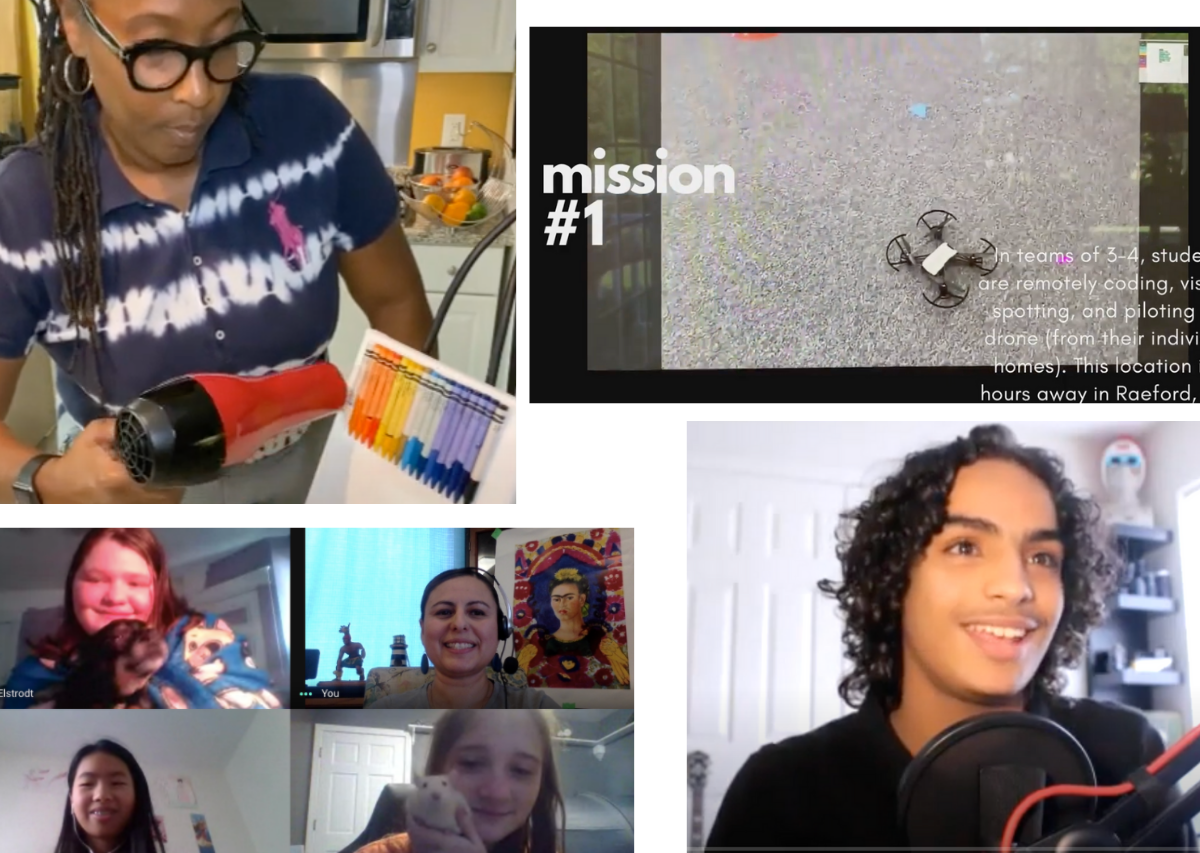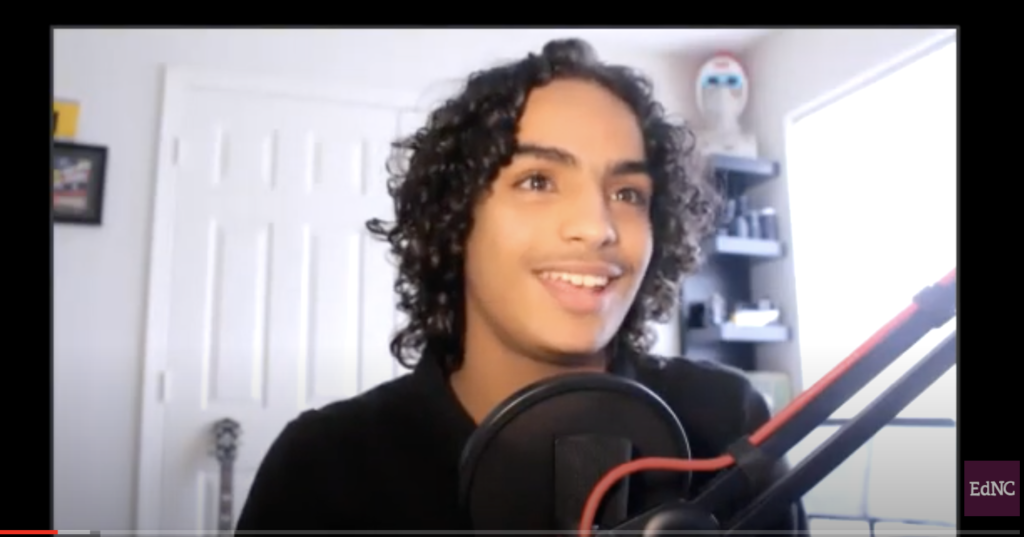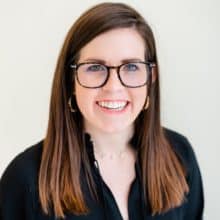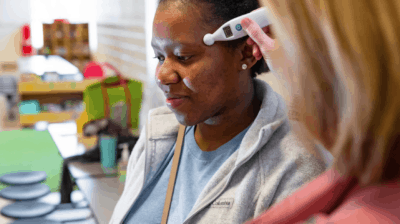
This is part of a series about the Pinch Points to Possibilities event series, focused on authentic innovation in education, hosted by Ben Owens and co-moderated by Dominique Stone, in collaboration with EdNC.
On July 16, seven educators and two students shared examples of how their school prioritizes student voice and social-emotional health in an hour-long webinar. These topics, plus equity and access, were selected as the most urgent issues for students and teachers based on an empathy mapping process completed in June as part of this series.
To build collaboration and imagine innovation for the fall semester, panelists shared real-world examples of forward-thinking lessons and ideas. From remote drone flights to weekly STEM video challenges and a student-run literacy summit, the examples varied by topic, grade level, and geographic scope. All have one thing in common: They put the students’ needs first and elevate their agency as learners.
Watch the full webinar below, and use the table of contents to explore the specific examples, submitted by educators and students.
Panelist-submitted examples
Question: Please describe the example you shared of student voice and/or meeting social-emotional needs of students.
Northeast Academy for Aerospace and Advanced Technologies in Elizabeth City (NEAAAT)
Submitted by Carolyn Walton, NEAAAT director of exceptional children’s and federal programs.
Community partners Agent Lamont Butts and Agent Barbara Morgan of the Elizabeth City Police Department are certified drone pilots. Their participation in the student remote drone piloting Zoom sessions brought a real-world connection to drones in the workplace.
NEAAAT coaches implemented a variety of practices to build SEL connections with students, including Coach Lelanie Armijo, who took time during remote classes for students to introduce and share their pets with their peers.
Seventh grade design thinking coach Caitlin McDonald used her own collection of mugs made by craftsmen she knows to connect her students to various art techniques featured in her class. This inside look to her connection with artisans allowed students to see the relevance of what they were learning. She was also able to use various online tools and sites to extend learning.
Eighth grade math coach Lindsey Cahoon used blended learning with her students, pairing traditional charts and diagrams with a shared digital screen as the students learned about quadratic functions.
The executive director of STEM, Tonya Little, issued video “STEM Challenges” to challenge students to participate in STEM activities using materials they could find at home. The following is a link to one of the videos that was issued on “National Crayon Day,” March 31.
Students were able to continue traditions such as the student talent show, serving as hosts and holding a pre-show red carpet event.
Below is a screenshot of one coach’s perceptions of teaching surveys, which she issues to students multiple times each semester. A similar survey is provided to parents with the same frequency. The collected data are used to inform her planning.
Perceptions of teaching surveys, which she issues to students multiple times throughout each semester. Courtesy of NEAAAT
NEAAAT students designed this website in response to a project-based learning assignment that required them to identify solutions to issues facing students.
One issue that surfaced was the need to help new students orient to our unique learning environment, so students designed a NEAAAT vocabulary website as a quick, student-friendly “go-to” resource.
Students included a quick explanation of the student proposal process, including a successful example (i.e., students were able to identify and have staff implement a different solution for seating), to make sure students know they have a real voice at NEAAAT.
North/Phillips School of Innovation in Edgecombe County
Submitted by Sayre Man, expanded impact teacher
About our school: We are a proud public school, and we believe that public schools can and should be some of the loudest advocates for equity in North Carolina.
There’s a long history of racial and socioeconomic injustice within the education system, and we believe that ending this injustice is essential to our purpose as an institution.
When we began our innovative journey three years ago, we were driven to pursue an equitable and liberating school design. This purpose became clearer and more urgent when the COVID-19 crisis disproportionately affected our students and community, revealing pre-existing issues of inequity across the education system.
About our approach: Our approach to meeting our students’ needs during these challenging circumstances is to empower them as agents of change. The aspects of learning at NPSI – design for change projects, passion and identity exploration, and social and emotional learning – work together to provide pathways by which students can use their passions and skills to change the world. The COVID-19 crisis is unprecedented, but its impact mirrors that of many challenges our students have already faced. In the past, our students have experienced being at the effect of larger systems of power. As we continue to navigate this situation, we want students to know that they are capable advocates with important voices.
Rowan-Salisbury School District
Submitted by Ali Khatib, rising junior at Salisbury High School

During my middle school years (sixth-eighth grades) in my AIG ELA class, my classmates and I were given the opportunity to work with the superintendent of Rowan-Salisbury Schools to help develop our learning environment and find ways to elevate all students to learn in their zones of proximal development.
In sixth grade, my class and I, with the guidance of Mrs. Angelia Fleming, wrote an article elucidating the myths associated with the recent introduction of technology (iPads, laptops, and other learning tools) into our school system. That article was later published internationally.
Later in our middle school adventure, we were tasked to create a keynote presentation for our district’s literacy summit.
At the time, the fascination with Lin-Manuel Miranda’s “Hamilton” had broken its way into our psyches and eventually into our classrooms. Rather than following the conventional route of presentation making, we decided to create a parody of “My Shot” describing how our world could’ve been had it not been for the literacy of history’s most influential figures.
We also created an entire “Night in the Museum”-esque narrative where the aforementioned historical figures came to life and educated our student protagonist on the importance of literacy.
What were the enabling conditions and actions that allowed this innovation to emerge (i.e., details that help others see how you went from A to B)?
Without the environment and school culture established in years prior at North Rowan Middle school, as well as Rowan-Salisbury Schools at large, the comfort shown by the students to try public speaking, lyrical ideation, and research would’ve been absent, to say the least. Not only that, but our class became intrinsically motivated and was legitimately interested in this topic. This isn’t something you’ll find in the traditional ELA curriculum.
What additional advice would you offer other educators who might consider adapting a similar approach to what you did in their own schools?
Two pieces of advice I’d offer … First, capitalize on the interests of your student body.
Just as we did, take a flame of engagement and stoke it into a raging fire that’ll motivate your students to think about the content from class when in other classes, lunch, or even at home.
Second, “awareness proceeds control.” Immerse yourself within your possibilities. If you’re an educator reading this, you’re doing just that.
Inform yourself about the educational practices being employed by innovative educators, as well as looking for novel and exciting practices that have yet to be used or even exist. By doing so you broaden your understanding of what it means to teach, as well as add another tool to your proverbial tool belt.
Submitted by Angelia Fleming, AIG Salisbury area lead teacher
The Literacy Summit Presentation was created and presented by the students. What began as two questions from Dr. Lynn Moody, superintendent of Rowan-Salisbury Schools — why is literacy important, and why do we need our community involved in student learning? — led to a student-driven project where every student was involved.
This project was student-owned from day one. I presented Dr. Moody’s challenge. Students then brainstormed ideas. They moved quickly from deciding to create a live performance rather than just a PowerPoint presentation. Our talented art and drama teacher, Leigh Ann Alexander, joined in to work with us. We created a live performance with a living wax museum, a literacy parody of Lin-Manuel Miranda’s “My Shot,” and an appeal to charge our community with becoming actively involved in our students’ education.
Students chose their parts, created their scripts, and in the case of the parody of “My Shot,” created the song. We practiced. And practiced. And practiced. Our class lived and breathed this production. The school actually resonated with their song and their speaking parts.
What I truly loved with this activity was the student involvement. In the beginning, a number of students did not want a speaking or performing part to present in front of 150 people. Each one of those students still figured out an important part to play as we worked on our production. It turns out, as our journey played out, every single student requested a speaking part. Each student got up in front of this impressive crowd and spoke and sang.
I am still amazed at the courage this took for some of my shy students. Students supported and encouraged each other throughout this whole process.
Each student was able to draw on their strengths and then coach each other. When they performed, the audience gave them a standing ovation, and there were tears on the faces of many, myself included.
Students owned their project. They brought it to life. As you heard from Ali, this performance still resonates with meaning for the students.
What were the enabling conditions and actions that allowed this innovation to emerge (i.e., details that help others see how you went from A to B)?
The direction of our superintendent, Dr. Lynn Moody, made this student voice project possible. Dr. Moody believes wholeheartedly in the power of student voice and choice. She presented my class with this challenge trusting that we would rise to the occasion and create and present a “wow” performance at the literacy summit. We also had the full support of our administration and other teachers, making this project possible.
What additional advice would you offer other educators who might consider adapting a similar approach to what you did in their own schools?
Trust your students. It is a mindset shift for a teacher to give up control.
I have discovered that by empowering students with voice and choice, they accomplish more than I ever imagined. Their creativity knows no bounds. They love to take action and bring their projects to life.
William R. Davie Middle School in Roanoke Rapids
Submitted by Jerome Williams, principal
STEM Remote Learning (Projects Based Learning at a Distance —PBLAAD)
Using interaction between teachers and students through blended instruction based in a virtual environment that focuses on the tenants of Project Based Learning at a Distance (PBLAAD).
The intent is to provide students with a bag of material that he/she can use to construct/design/test a STEM-based project. Each project will embed learning standards in ELA, math, social studies, and science (i.e., the four core content areas). The bag will be distributed once a week for four weeks. STEM bags will contain instructions allowing the student to authentically experience teaching and learning modalities by employing his/her five physical senses.
This type of experiential teaching and learning promotes the teacher being a facilitator of learning and the student being more responsible for mastery. Students will construct or design a three-dimensional project that relates to specific fundamental STEM principles. The project will serve as an assessment of “how well the student is able to combine specific concepts and demonstrate an in-depth understanding of the standards.”
Grading rubrics will determine the mastery of the subject through this authentic learning experience. Students will provide feedback via virtual reporting, Google class, Clever, Zoom meeting, Facebook Live, or any decided social media platform.
All artifacts from students will be displayed in a virtual showroom on the school website. Virtual completions and individual challenges will be held via video streaming, at the end of the four weeks.
The goals are simple: Increase student engagement, deep learning, creativity/critical thinking, and parent involvement.
Each week, a select group of students will be presented with a STEM bag of materials that will correspond to several fundamental standards from DPI and NGSS. These projects will continue through the summer.
Do you have any questions about the submissions above? Or want to get in touch about your own innovative student voice projects? Email MWillson@EdNC.org.
Join the next webinar in this series
Thursday, August 13 | 4-5 p.m.
Sign up for this webinar here.
The final webinar in the Pinch Points to Possibilities series will be a conversation between education leaders who have walked the innovation journey (i.e. schools/districts that have garnered state or national recognition for their efforts) and educators who are ready to do the same, but are in the early stages of that process.
The goal is that we create a “virtual fishbowl,” where audience members — teachers, administrators, and other education stakeholders — can be inspired to action while listening to practitioners from the field as they unpack “the how” of innovation rooted in student voice and SEL. In other words, we come full circle by enabling a rich conversation that gets under the hood for how one makes this change happen, thus enabling others to adapt and scale equitable, transparent, and learner-centered innovations to more schools, districts, and networks across the state.


